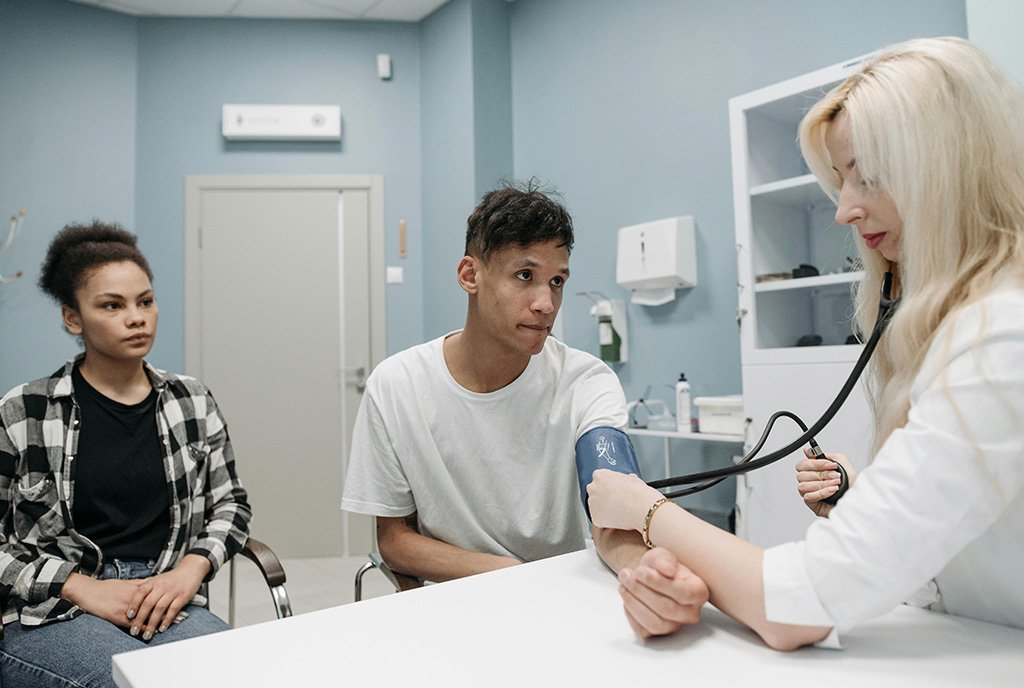
A recent study published in January by George Washington University revealed a significant rise in permanent forms of contraception, such as tubal ligations and vasectomies, following the Supreme Court’s 2022 decision to overturn Roe v. Wade. The increase was especially pronounced in states that were likely to ban abortion, reflecting a growing fear about reproductive rights among young adults, as captured in a survey of 638 participants.
By mid-2024, conversations around contraception in the United States intensified once again—not just in response to abortion access restrictions but due to new developments in male contraception.
For decades, the burden of birth control has largely fallen on women, but emerging technologies suggest a future where men, too, could take contraceptives. At a time when women’s bodies are consistently part of the political debate, the possibility of shifting some responsibility to men has gained renewed attention.
But there’s another aspect of the conversation that must be considered: Can contraceptives be sustainable? And what does sustainable contraception look like?
Many side effects that have stalled male contraception development mirror those women already deal with when taking birth control.
The Slow-Moving Field of Male Contraception
Human trials for a new male birth control gel—which suppresses sperm count when applied to the shoulders—have shown promising results after years of research. Other nonhormonal options, such as injectable gels that would block the vas deferens, are also being tested in small-scale trials.
However, even with the potential of male contraception, many critics point out that progress isn’t fast enough. This is despite the fact that a survey conducted in 2022 in the United States and other parts of the world showed that there was high demand for other forms of male contraception.
One reason for the slow progress is the failure of previous trials due to men dropping out or, in the case of injections, not agreeing to the schedule of taking the contraceptive. While the topical gel has moved into human trials with few reported side effects, showing a promising future, the lack of support is mainly due to a lack of funding, which continues to hinder progress.
In some trials, the few side effects that did emerge included mood disorders, which made male candidates uncomfortable. This has also led critics to point out that there’s a higher concern for side effects when it comes to male contraception and an inherent double standard—many side effects that have stalled male contraception development mirror those women already deal with when taking birth control.
Other experts like Professor Richard Anderson at the University of Edinburgh believe that the lack of progress may be because the pharmaceutical industry doesn’t believe there is enough of a market, making the decision one based on economics.
Regine Sitruk-Ware, a distinguished scientist at the Population Council’s Center for Biomedical Research (CBR) and a reproductive endocrinologist whose work focuses on finding better, healthier alternatives to existing options for both male and female contraceptives, notes that male contraception has the potential to be “greener” than female options since nonhormonal and mechanical methods are easier to develop sustainably.
What Does Sustainable Contraception Look Like?
Sustainability in contraception is more than just being “eco-friendly.” It covers many aspects and is more complex than being labeled as “green” or “natural,” especially when it comes to sustainable human impact.
Whether it’s biodegradable implants that dissolve after a set period, technology that supports low-waste procedures, long-lasting contraception to reduce healthcare burdens, or ethical considerations to ensure contraception is accessible and equitable, sustainable contraception could go a long way in addressing the gaps in reproductive care faced by vulnerable communities across the United States and the globe.
FHI 360, a nonprofit aimed at making healthcare accessible, is currently conducting a trial for a biodegradable implant in the Dominican Republic—marking the first such trial in over 20 years. The trial will look at the impact on users and the effectiveness of a device that will dissolve after a set amount of time, limiting the number of trips to the doctor, which could significantly improve access to those with limited resources.
“If something is resulting in more births, can that be considered a sustainable method?”
“A biodegradable implant, such as Casea S, can boost access and convenience by reducing the need for repeat visits to health facilities and simultaneously lessen costs and other burdens to individuals and health care systems alike,” Dr. Kavita Nanda, director of medical research at FHI 360 and principal investigator of the Casea S study, said in a press release.
But sustainable doesn’t only mean biodegradable. In an interview with NPQ, Sitruk-Ware points out, “There are at least two meanings as it could be either long-acting contraception that will last for several years or relate to ‘green contraception,’ [which is] more eco-friendly, with less hormones or nonhormonal.”
Along with being green, Sitruk-Ware also notes the importance of ethical contraception, allowing users choice and being long-lasting: “In terms of ethics, I think it’s really needed for women and men too to control their own fertility. We need to have gender equity, so I think it’s important we develop an array of methods so that women and men can choose different times and different impacts.”
Elisa Wells, cofounder and access director of Plan C, which provides abortion pills by mail, agrees. “Having choices is probably the most accepted thing about contraceptive access—so the more types of methods we can make available, the more likely someone will find a method that’s more available to them,” she tells NPQ.
Wells also raises a key point: Population increase itself is unsustainable. “If something is resulting in more births, can that be considered a sustainable method?”
Sign up for our free newsletters
Subscribe to NPQ's newsletters to have our top stories delivered directly to your inbox.
By signing up, you agree to our privacy policy and terms of use, and to receive messages from NPQ and our partners.
One of the challenges of developing sustainable contraception, Wells notes, is that because medical research is often funded by donors who want to see the impact, it is more focused on their perspective than what users prefer.
“Things that are under [the] control of people using them are very appealing to people, such as things that are at certain times in the cycle, not every day,” Wells says. “The work done on a once-a-month pill, there’s work being done on other forms of abortion care, period pills, so there’s all sorts of innovative thinking.”
How that contraception is made is also an important question. As Wells indicates, it is the most vulnerable groups who are affected most by factories and the environmental waste produced by industries. When talking about sustainability, those most impacted must be front and center of discussions around impact.
The Trump Administration and Barriers to Access
For many people in the United States, particularly vulnerable populations, access to reproductive health procedures and contraceptive care is becoming increasingly harder. Project 2025, which outlines restricting access to reproductive care, including contraception, has served as a roadmap for Trump’s presidential agenda.
Two weeks into his second term, reproductive rights are already under threat. Through two executive orders, President Trump has repealed two of Biden’s executive orders meant to protect and expand reproductive healthcare, issued in response to the Supreme Court’s decision in Dobbs v. Jackson which overturned the constitutional right to abortion.
Of the two Trump executive orders, “Enforcing the Hyde Amendment” is arguably the more damaging. It denies abortion coverage to those enrolled in the federal Medicaid program, as well as to those who rely on federal healthcare programs, such as military servicemembers, veterans, and federal employees.
The changes put forth by this administration mostly impact low-income women, many of whom have been relying on access to contraception to prevent pregnancies—and the financial burden that can come with them—provided by the contraceptive coverage guarantee. In some states, private insurers may also be impacted in order to comply with federal rules. As the National Women’s Law Center states:
Not only does this Trump executive order misapply and misuse the Hyde Amendment, but it also exploits biases and unfounded assumptions about public funding for abortion care. This is a cynical ploy that is meant to hide Trump’s action to block a range of initiatives to expand reproductive health care. And it demonstrates that Trump intends to use his power to further entrench the harmful coverage bans that have for decades created often insurmountable barriers to abortion for many women across the country, disproportionately impacting people with low incomes, people of color, young people, immigrants, and people who live in rural communities.
Along with the executive orders, the Supreme Court is set to hear a case this term on limiting birth control coverage under the Affordable Care Act, which would further jeopardize access to contraceptive care.
With misinformation about reproductive care becoming more frequent under Trump, advocacy groups…are taking a greater role in educating the public.
While advocacy groups gear up to defend access to reproductive healthcare, many advocates also advise fighting misinformation online and raising awareness around the real nature and importance of contraceptive care—such as where long-lasting contraception or any contraceptive care that requires fewer doctor’s visits could be much more helpful for users.
“More recently, a one-year contraceptive vaginal system has been approved by the FDA, and this one-year-long method does not need a health provider to insert or remove,” says Sitruk-Ware, sharing some of the research being done by the Population Council on more accessible forms of contraception. “It provides the woman with a full year [of] contraception, and she does not need to go to the pharmacy for refill prescriptions. Research is also ongoing to provide long-term injectables with less side-effects than the current methods. Also, reversible vasectomy for men will bring a new long-acting method for men without any hormonal intake,” she says.
With misinformation about reproductive care becoming more frequent under Trump, advocacy groups like Plan C and Hey Jane are taking a greater role in educating the public on reproductive healthcare and contraception options.
Crystal Pérez, founder of Bloodys Red Tijuana, a Mexican abortion advocacy group now working in the United States following the overturning of Roe v. Wade, emphasizes the need for public awareness.
“So, now it’s not just that we’ve been trying to promote the access to pills and self-manage[ment], but also to promote the movement so more people can be a part of the huge network this country needs,” she tells NPQ. Pérez also acknowledges the importance of building networks of people who are educated about their reproductive rights and what medical care is available to them.
Future Innovation and the Role of Advocacy
As reproductive healthcare access is increasingly politicized, advocacy for contraceptive choice is crucial.
Regarding the future of contraception development, Sitruk-Ware says, “Advocacy groups could promote male contraception and also gender equity to engage industry in the development of new methods for women and men, including biodegradable implants. Conducting surveys of the acceptability of new products should be included in the early development stage to inform the developers of the users’ preferences. Such studies were conducted for male contraception, and the results showed an increasing demand for such research.”
In a rapidly shifting landscape, ensuring sustainability—in all its forms—remains a priority for reproductive care. These innovations could close the accessibility gap, providing better contraceptive choices for everyone, regardless of gender or income.











